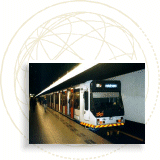home | nieuws | projecten | www-links | bibliotheek | vraag het RCM
London Underground Crime prevention measures In 1988, the Steering Group initiated the implementation of three pilot projects to reduce robbery on the south end of the Northern line, reduce theft and assault at Oxford Circus, and reduce fear of crime at stations on the east end of the Central line. These pilot projects included measures aimed at improving closed-circuit television surveillance of stations, improving radio communications for both police and staff, installing passenger alarms on stations, and making use of passenger information systems such as Public Address and dot matrix indicators. At the end of 1989, a new automated ticket issuing and collecting system was brought into full operation at 63 busy central stations. This measure cut down fare dodging by twothirds reducing it from 6.2% to 6.0% in 1989 and down to 1.9% in 1990. Recently, the rates have gone up a bit again since passengers have started to learn new ways to evade the system. Nevertheless, the introduction of the automated fare collecting system has proved itself to be a very successful cost-effective measure. One of the most successful crime prevention measures within the London Underground was taken in 1991 with the redesigning of Ladbroke Grove Station and the installation of a Group Security Information Room on one of its platforms. This security unit monitors all CCTV images of the 7 stations of the eastern part of the Hammersmith & City Line as well as all emergency calls from its information & emergency intercoms (Help Points). All video and audio monitorings are recorded on a 24 hour basis and kept for a period of 28 days. Special care is taken to keep the quality of the recordings high. The station itself is redesigned and equipped with designated waiting areas which are shielded with transparent walls and equipped with Help Points and designated cameras. This approach has proved to be a big success. Ladbroke Grove used to be one of the most unsafe stations of the London Underground with a high number of muggings, assaults, pickpocketings, and graffiti. Now the crime rates have dropped 70%. |
|||||||
|
|||||||
Source: López, M.J.J., Crime Prevention Guidelines for the Construction & Management of Metro Systems, Den Haag: RCM-advies 1996, pg. 15-18. |

 The British government bravely took up the issue of the skyrocketing
crime rates in the country and formulated some initiatives in
which the recent scientific knowledge on crime prevention techniques
were put in practice. One of the initiatives to emerge from this
was the appointment of a Steering Group which aimed to formulate
crime prevention measures to reduce crime within the London Underground.
The difference in crime prevention approaches before and after
the formation of the Steering Group is well expressed by R.H.
Meads. "In the past, measures intended to combat crime have
tended to be spin-offs or additions to measures adopted for other
reasons. They have also tended to be systemwide, rather than targeted
on specific areas or specific problems. As a result, they have
been expected to help cope with crime in a general sense, without
taking into account the characteristics of different types of
crime. When specific action has been taken, it has tended to be
ad hoc rather than part of a co-ordinated approach. Furthermore,
because crime prevention has not normally been seen as a primary
objective for new investments or working methods, little has been
done to monitor their effect in preventing crime" (Meads
in: ECMT; 97-98).
The British government bravely took up the issue of the skyrocketing
crime rates in the country and formulated some initiatives in
which the recent scientific knowledge on crime prevention techniques
were put in practice. One of the initiatives to emerge from this
was the appointment of a Steering Group which aimed to formulate
crime prevention measures to reduce crime within the London Underground.
The difference in crime prevention approaches before and after
the formation of the Steering Group is well expressed by R.H.
Meads. "In the past, measures intended to combat crime have
tended to be spin-offs or additions to measures adopted for other
reasons. They have also tended to be systemwide, rather than targeted
on specific areas or specific problems. As a result, they have
been expected to help cope with crime in a general sense, without
taking into account the characteristics of different types of
crime. When specific action has been taken, it has tended to be
ad hoc rather than part of a co-ordinated approach. Furthermore,
because crime prevention has not normally been seen as a primary
objective for new investments or working methods, little has been
done to monitor their effect in preventing crime" (Meads
in: ECMT; 97-98). Order
this book
Order
this book